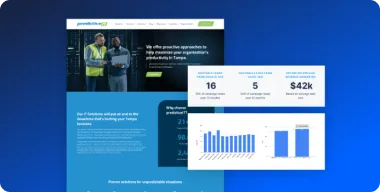You might think that the boom in social media, mobile apps, dynamic websites, and remarketing ads has rendered email newsletters obsolete. And yet, they continue to thrive.
Some experts believe that email newsletters — a “finite and easily recognizable commodity” delivered via the world’s most popular communication platform — help us make sense of the confusing barrage of information coming from an increasing variety of unfamiliar channels.
Whatever the reason, email newsletters continue to be one of the most robust marketing strategies for serious ROI. The time spent creating a campaign compared to the payoff is a marketer’s dream come true.
Why are newsletters so valuable?
Think about it, for leads to sign up for your newsletter they must have visited your site and either made a purchase, or had enough interest in your product to request regular “reminders.” That’s quite literally the perfect subset of leads to market to.
One of the most crucial variables for getting the most out of this goldmine is message frequency. Because on the one hand, if you send newsletters too often they feel intrusive, like a car salesman who’s trying too hard. On the other hand, if you send newsletters infrequently they’ll get lost in the clutter of customers’ inboxes. Zeroing in on the optimal frequency is essential to increasing the ROI of your email newsletter, and what follows is our tried and tested method to figure that out.
Set up your test groups
Depending on the size of your email list, you’ll be able to test everything you need in just a few weeks. To accomplish this, you’ll need to segment your email list into a few groups of 300 subscribers, though 500 subscribers is even better if your list can support that many.
In a perfect world, you will remix these segments after you test each variable for more consistent results. Even with a group of 500, there’s a chance that a couple dozen duds ended up on the same list and skewed your results. From there, it’s just a matter of testing different variables with different lists.
What’s the best day of the week and time of day?
The only real way to clarify your optimal newsletter circumstances is to test everything. Start by determining which day and time gets the best results with your readership. Send the exact same newsletter to the segmented groups you created, using different days and different times for each group.
For example, if you want to test the day of the week, send one segment a finished newsletter on Monday and another the same newsletter on Tuesday. Analyze and compare the results, and apply the same methodology to different times of day. Don’t be afraid to experiment — for all you know, Friday at 9pm could be a winner!
Clear trends should emerge that show when your customers are most likely to open your newsletter. A cajun cooking newsletter is going to perform a lot better before lunch rather than after, and a managed IT services provider’s newsletter will get better results on a Monday rather than a Friday.
Now we can talk about frequency
Once you’ve settled on a day and time, only then can you begin experimenting with frequency. Some case studies suggest that sending an email newsletter more than once a week is a big mistake, but obviously that’s an overgeneralization. Start out with two times a month, then try five. Those case studies were someone else’s business, only you know what’s best for you!
Of course, when you increase your frequency make sure you’re sending out quality content. If you’re hastily slapping something together just to test out how more frequent newsletters perform, your results will tell you more about the content than your control variable. Nothing reflects worse on your company or brand than lazy and low-quality content.
Consistency
Do you remember learning about the scientific method in high school? Because it’s finally going to be worth something. While experimenting with any of the variables above, everything else has to remain exactly the same — email subject lines, content, all of it. Engagement is impacted by every little detail in your newsletter, and if more than one is changed it’ll be impossible to interpret the results.
How to measure the results
The best testing methodology on the market doesn’t mean squat if you don’t know how to interpret the results. You need to focus on two key metrics: click-through rate and your opt-out rate. Obviously, more click-throughs mean more sales, and more opt-outs mean dwindling interest.
These are experiments, and that means you will be sacrificing some readers to get to the bottom of which days are total duds, and that’s OK. When all’s said and done, your newsletter campaigns will be significantly more successful than when you started.
Keep on testin’
Once you’ve found the best time, day, and frequency that work best for your business, then you can begin testing different subject lines, short and long form content, photographs and vector artwork, and anything else you want to run through the compare-and-contrast testing model.
In a perfect world, this will eventually apply to the creation email lists that are purchase-specific. For instance, you might have 300 email addresses tied to the sale of a specific item. That’s a great opportunity for a campaign that showcases promotions or updates about accessories for just that item.
Outsource the heavy lifting
All of this assumes you have the time and resources to dedicate several hours per week to creating, tweaking, analyzing, and refining your newsletter campaigns. Remember, nothing hurts your brand like content that looks careless. But when you outsource your email newsletter to marketing professionals, that’s something you’ll never have to worry about.
As your outsourced online marketing manager, Pronto handles everything on your behalf — from creation and delivery to subscriber list management and reporting on key metrics. Sound like a better model? To learn more, get in touch with us today.




